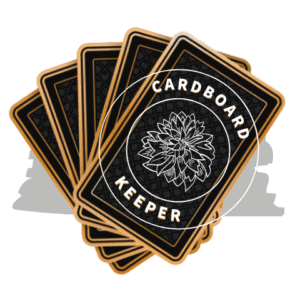Magic: The Gathering is an incredibly popular trading card game. It has been around for over 30 years and is played by at least 35 million people. There are so many elements to learn about Magic in order to play successfully, and one of those is coming to understand basic land cards and how they help you in the game.
In total, there are 5 types of basic lands in Magic The Gathering: plains (white), island (blue), mountain (red), swamp (black), and forest (green). Lands are essential to play the game, and allow you to cast spells by “tapping” them for mana.
Each land will help you to produce mana (which is the main resource of the game). Mana is essential to play cards in the game, and so gaining mana through lands is often the difference between winning and losing the game.
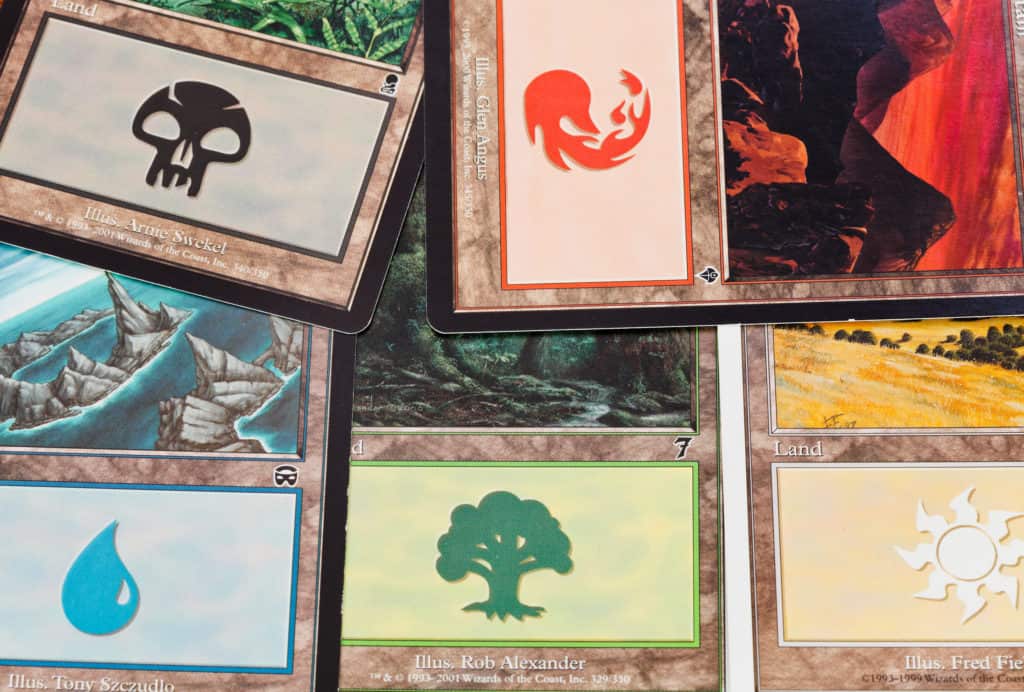
What is Mana?
In order to understand the basic lands we will talk about, we must also talk about mana.
Mana is the main resource of the game and allows you to play cards and progress in the game. It allows you to cast spells and other abilities to advance your game plan, whether that be comboing off, controlling the pace of the game, or going aggro against your opponents.
Cards, such as spells and creatures, require specific types of mana to cast.
Other cards, like some spells, creatures, and artifacts, can use any type of mana.
In order to tell what a card requires, look at the top right-hand corner of the card. This is called the Mana Cost. There may be a number in a circle next to a symbol, or there may be quite a few different symbols, it just depends on the card.
Each card has symbols in the top right corner of the card which represent the mana cost.
It tells you how much mana you will need in order to play the card.
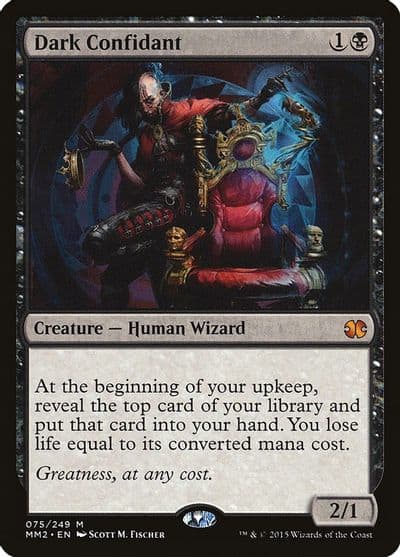
For example, the card Dark Confidant (aka “Bob“) has the mana cost of 1B which means it needs 1 mana of any color (or type) and at least one black mana. Each card varies and uses different colors or types to fulfill the mana costs.
There are 5 different colors of mana and 6 different types of mana. The 6 different types of mana are:
- White
- Blue
- Black
- Red
- Green
- Colorless
Most of these types of mana are considered a color, besides the colorless mana.
This one is solely considered a type of mana, as colorless is not a color. Each card has a mana cost, as do many abilities, some of which require a specific type or color, and some that can use any mana in general.
Lands are the most common producer of mana, although creatures and artifacts also commonly produce mana and, planeswalkers, enchantments, instants, and sorceries can produce mana as well but not as often.
It is important for players to have enough mana so that they can use their different abilities and spells.
What is a Basic Land?
The basic land cards of the game give you the power to progress with all different colors and types of mana.
They are one of the most important cards in the game because they provide the resources that are needed in order to play with different creatures, spells, and more. Without lands, you can’t play the game.
There are a few different types of basic lands which include:
- Plains
- Forest
- Mountain
- Island
- Swamp
There are also basic Wastes land cards, but they are not as common as the other basic lands that were mentioned before.
Basic lands are a supertype of lands, meaning that the word “basic” will appear before the word land in the type box.
If the word basic does not proceed before the word land, that just means that specific card is a normal land. In any deck of MTG cards there can be any number of basic lands in the deck.
The difference between a basic land and a normal land is that a deck can only have four cards of any normal land, whereas there can be any number of basic lands in the deck.
There are also many spells and abilities that care about basic lands specifically, such as doing something based on how many you have in play or searching them from your library.
In general, a deck of MTG cards will be made up of 30% – 40% of basic lands and lands in general.
Lands act as a cornerstone to the game because they generate most of the mana, although other cards can generate mana as well. This is very important to the game because more mana generated from lands allows the players to use more abilities and/or spells.
You can only play one land during each of your turns of the game, unless there is a card that states otherwise.
To utilize the basic lands, you must “tap” or turn the card 90 degrees to its side. This is how you can generate a single mana.
The mana that is generated can be used quickly, or they can be saved in a mana pool. However, at the end of every step or phase, the mana pool has to be emptied.
What Subtypes of Basic Lands are There?
Each basic land has a subtype that creates different types of mana.
These different subtypes include:
- Plains
- Island
- Mountains
- Swamp
- Forest
- Wastes
- and snow-covered variants.
Each land provides a different color or type of mana, which is necessary for casting spells, using different types of creatures, and other abilities.
Mana costs might utilize specific types of mana, which will be mentioned in this list of the different basic lands.
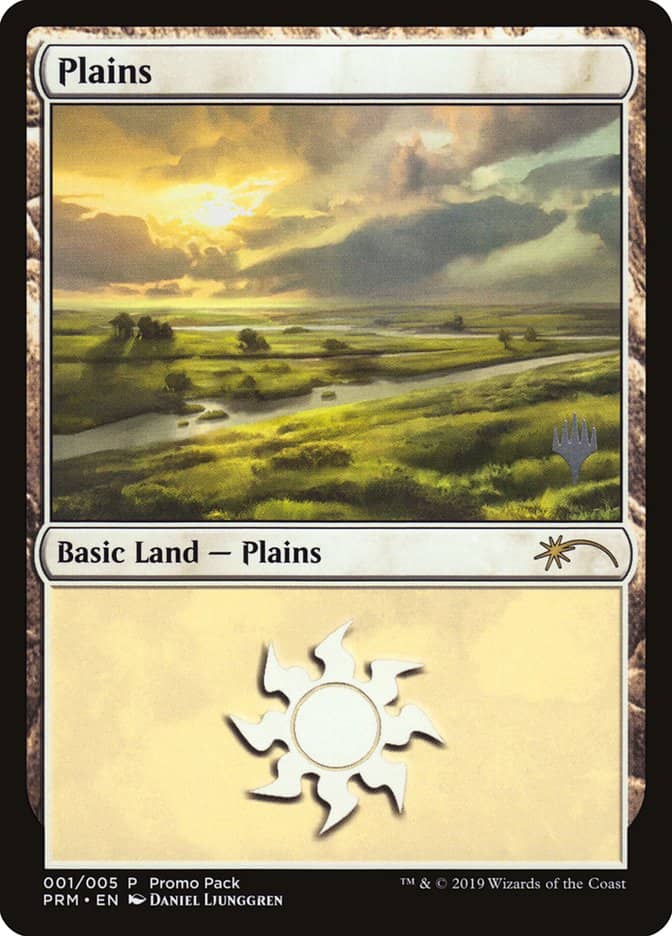
Plains
Plains provide white mana with the sun symbol. This means that plains can produce specific mana that can be used to cast white spells.
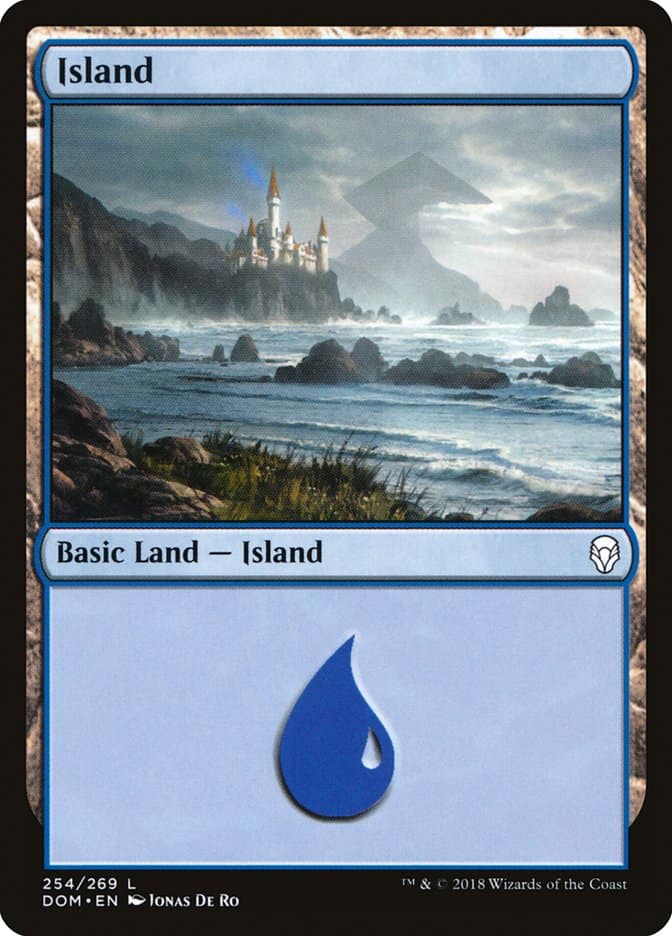
Island
Island basic lands provide blue mana with a waterdrop symbol. Just as plain’s mana generates white mana for white spells, blue mana is required to cast blue spells.
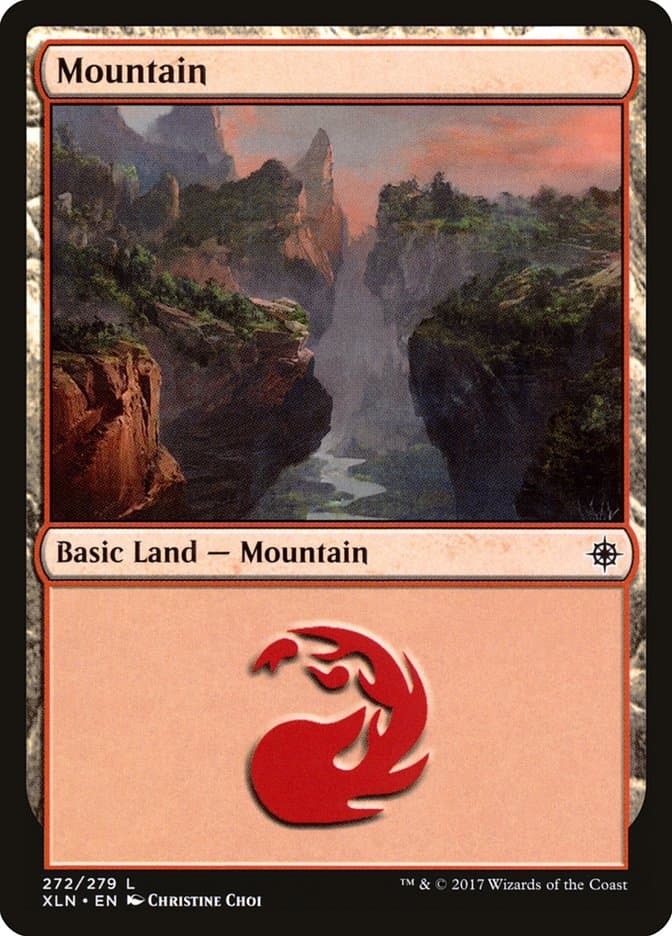
Mountain
Mountains provide red mana with a flame-looking symbol. These can be used for cards to cast red spells.
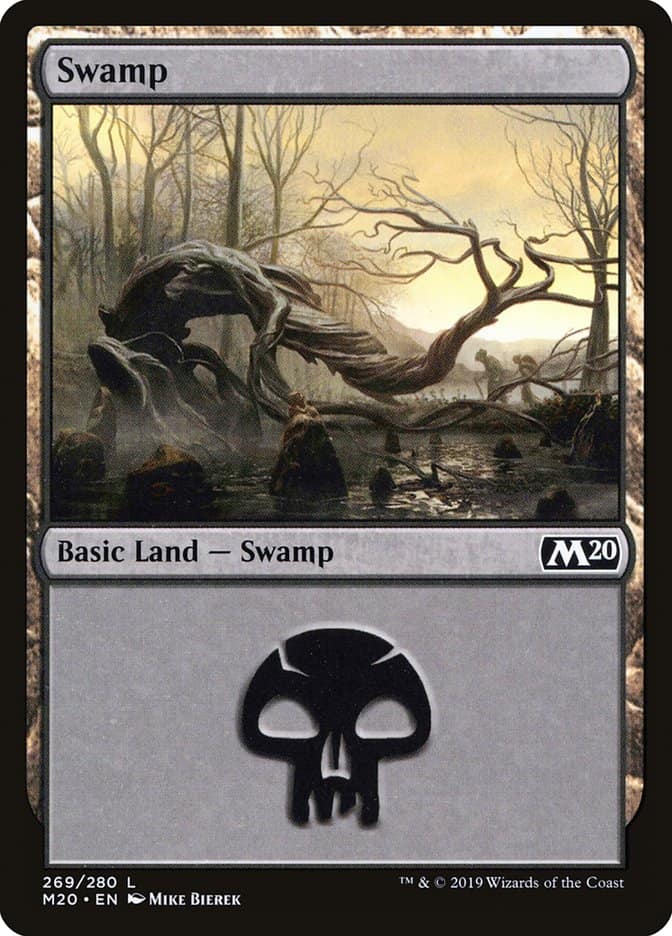
Swamp
Swamps provide black mana with a skull symbol. Swamp mana can be used to cast black spells.
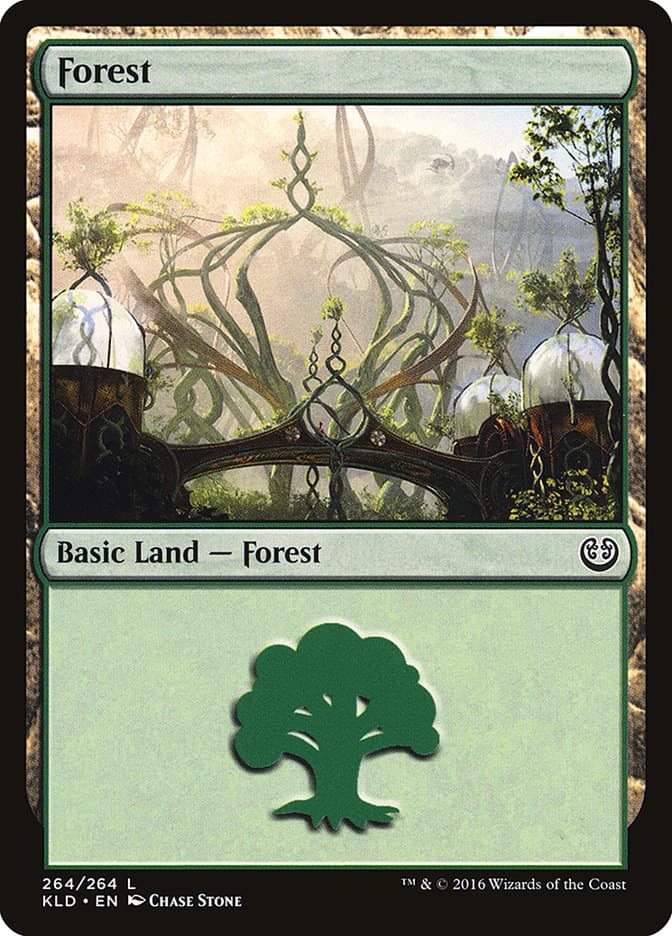
Forest
Forests provide green mana with a tree symbol. This type of mana can be used to cast green spells.
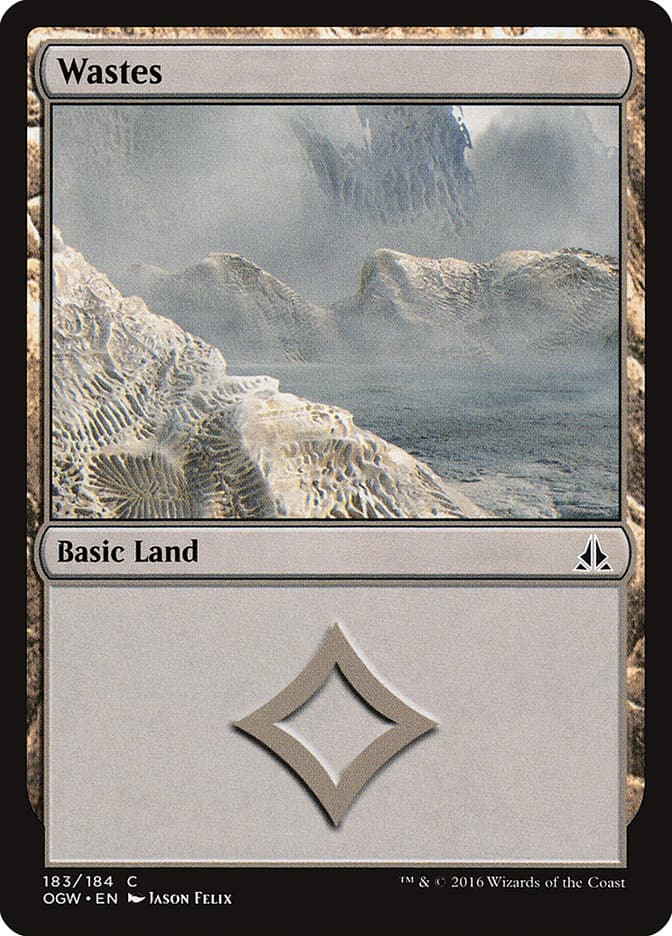
Wastes
Wastes provide a colorless type of mana with a diamond symbol. This is a basic land with no subtype, meaning that the words “plains”, “forest”, “mountain”, “swamp”, nor “island” will follow after the word “waste.”

Snow
Snow is similar to the other basic lands, but it is a variant to each of the lands.
This means that there are:
- Snow-Covered Plains
- Snow-Covered Mountains
- Snow-Covered Forests
- Snow-Covered Island
- Snow-Covered Swamp
There isn’t much of a difference between the basic lands and the snow land variants besides the fact that snow lands can generate snow mana, which can be used for certain abilities.
The number in the circle signifies the amount of any type of mana that you can use to cast a certain ability. This means that a player can use whatever mana they would like.
The symbols with color (or the colorless symbol with a diamond from a Waste land) mean that you must use that type of mana to use a certain card.
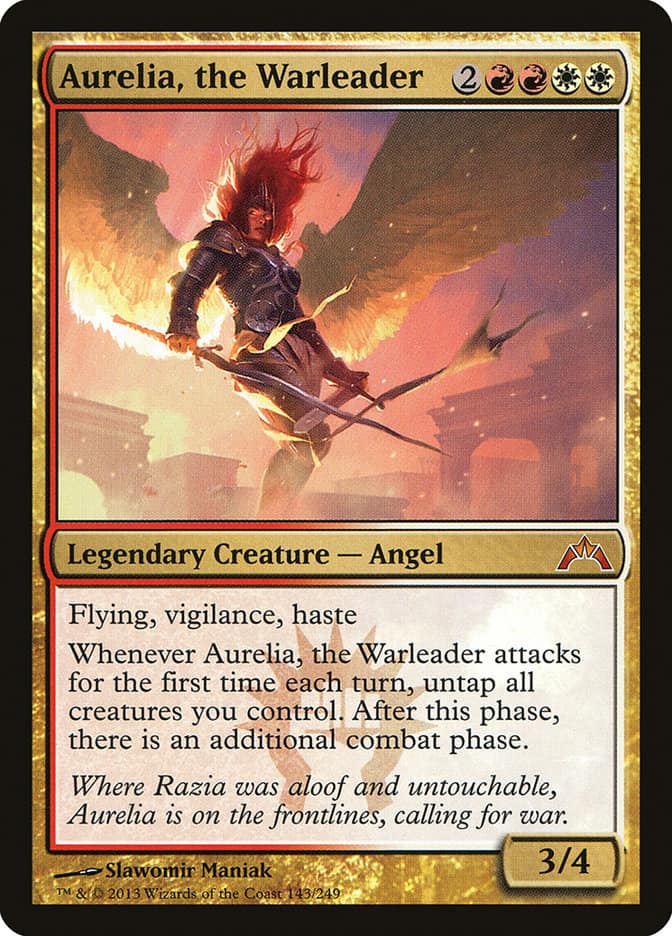
For example, if a player wants to use the creature Aurelia, The Warleader, the mana cost of this card has 2 Mountain symbols and 2 Plains symbols.
There is also a number to the left of these two different symbols, which is the number 2 in a circle. This means that you will also need to add two mana of any type in order to cast this card.
Of course, the mana costs of cards will vary and use different types of resources.
This is why it is crucial that players have different types of basic lands in their deck according to the colors of the cards they play so that they can utilize any kind of ability and cast all of their spells.
-
What Are Fetch Lands – MTG Fetch Lands: Types, Rules, List
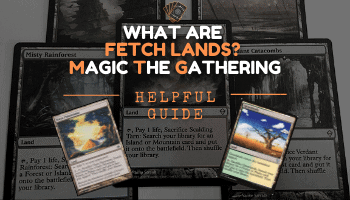
Ever since their original printing, Magic The Gathering players haven’t stopped talking about fetch lands. The first time I ever attended Friday Night Magic, someone tried to explain to me
-
When To Buy Fetchlands: What You Should Know
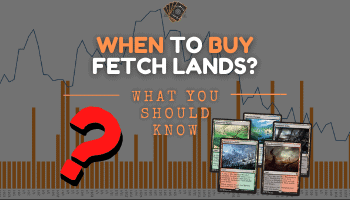
When I started to play Magic The Gathering competitively and build build decks in the Modern format, I knew I would need to buy the fetchlands at some point. But
-
Will Fetch Lands Be Reprinted: [Wotc Official Statements]
![Will Fetch Lands Be Reprinted: [Wotc Official Statements]](https://cardboardkeeper.com/wp-content/uploads/2021/05/Will-Fetch-Lands-Be-Reprinted.png)
One of the biggest barriers when starting to play Magic The Gatherings eternal formats is the high costs of fetch lands due to a lack of reprints. If you want
Using Basic Lands in Different Phases
Magic can be a very complex game with lots of levels of understanding and knowledge.
To truly understand how to use basic lands, it is best to know how the gameplay works in general.
Of course, Magic: The Gathering has hundreds of thousands of different ways that it can be played, so to make it more simple, we will only go over the different phases to understand when to use your basic lands in a game.
Everyone has different strategies that they prefer, but it is very important to get lands down as much as possible to generate mana for the different spells and creatures in your deck.
During every single turn, you are able to play one land per turn. This allows you to generate the mana that you need to cast certain spells. Without the basic lands, it can be harder to use different artifacts, spells, instances, creatures, or enchantments.
In MTG, we call having too much mana and drawing too many lands: being Mana Flooded.
Having too little mana and not drawing the lands you need to cast your spells is called: being Mana Screwed.
In every single game that you will play of Magic: The Gathering, there are quite a few different phases within a turn and they include:
- Untap
- Upkeep
- Draw
- First Main
- Combat
- Second Main
- End Step
- Cleanup
Within these phases, there are only two different phases where you are not able to tap your basic lands.
These phases where you cannot tap your basic lands are the untap and cleanup phases. You are able to tap lands during your opponent’s turn if you choose to do so, but you will only be able to activate abilities and cast instants and spells with flash.
During the untap phase, players untap their cards, such as their basic lands and creatures.
To untap a card, the player will simply take their card that has been turned 90 degrees to the side horizontally and then flip it back so that the card is vertical. This signifies that it’s ready to be used again.
You put the mana that you have generated in a certain phase into a mana pool, but it’s important to be aware that anything leftover in your mana pool disappears once you move onto the next phase.
For instance, if you have generated 3 blue mana in the first main phase, and you use a card that requires 2 blue mana, that means that you will not be able to use the leftover blue mana if you move onto the combat phase.
The cleanup step is an automatic step and is the last part of the ending phase.
All of the cards in a hand that exceeds 7 must be discarded at this time. Not only can basic land cards not be used at this time, spells and other abilities cannot be activated also.
To understand more about the different phases of MTG and the basics of the game, take a look at this video.
The above video explains more than just the basic land cards, but he shows when those lands can be tapped and explains that you can use the basic land cards whenever you want (besides tapping and clean up phases).
This video is very helpful for beginners as it explains using lands in gameplay.
The basic land cards are ultimately the cornerstone of Magic: The Gathering as they are the most common way to generate various types of mana.
It is not very complex to understand how to use the basic land cards, as they are just used to generate the resources of the game.
Although this is just a basic description of mana, with a foray into the game, MTG can be quite creative, complex, and lots of fun.
It’s important to understand the basics of this game so that you can start learning how to play with more advanced MTG players.
